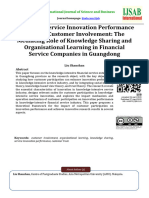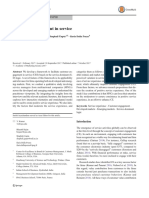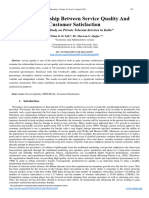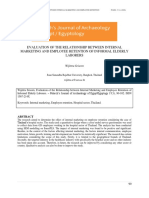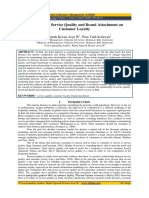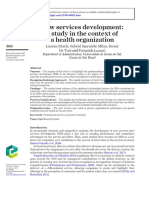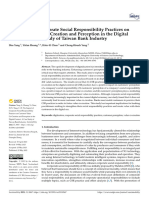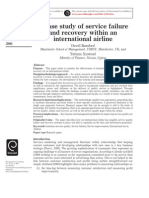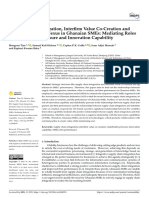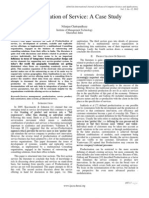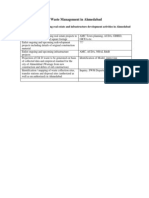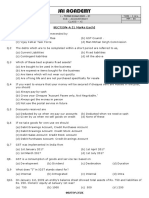Professional Documents
Culture Documents
Supply Chain Integration and Customer Service at Hariss International Limited Uganda
Original Title
Copyright
Available Formats
Share this document
Did you find this document useful?
Is this content inappropriate?
Report this DocumentCopyright:
Available Formats
Supply Chain Integration and Customer Service at Hariss International Limited Uganda
Copyright:
Available Formats
Volume 8, Issue 10, October – 2023 International Journal of Innovative Science and Research Technology
ISSN No:-2456-2165
Supply Chain Integration and Customer Service at
Hariss International Limited Uganda
Cigiriza Samuel1, Olutayo K. Osunsan 2, Moses Muhwezi2, Christine Kabasinguzi2,3
1
MBA Student, School of Postgraduate Studies & Research, Cavendish University, Uganda
2
Lecturer, Faculty of Business and Management, Cavendish University, Uganda
3
Lecturer, College of Economics and Management, Kampala International University, Uganda.
Abstract:- The paper accesses the relationship between ignore (Kumar, Dalla Pozza & Ganesh, 2013). Soosay, Ferrer
supply chain integration dimensions (customer and Santa (2021) stated that organizations confront
integration, supplier integration, internal integration) significant problems today since the successful provision of
and customer service at Hariss International Ltd. The numerous goods and services necessitates the effective
study employed both descriptive and cross-sectional integration of logistical activities across a growing supply
designs, utilizing quantitative data collection methods. A chain and increasing geographical isolation (Soosay, Ferrer
sample of 36 employees was chosen from the organization and Santa, 2021).
for data collection. Primary data was collected through
interviews and surveys, while secondary data came from In Africa, customer service is still a challenge. Thaba,
records and published sources. The study utilized Jacobs and Laby (2023) that customer experience service
statistical tools such as correlation analysis, multiple levels in South Africa have continued to drop over the last
regression analysis, and factor analysis to analyze the five years, as has customer loyalty to brands. The emotional
data. The results reveal significant positive relationships and service-related components of the consumer experience
between customer integration, supplier integration, are both declining. In Uganda, generally customer service is
internal integration, and customer service. The findings considered moderate. Wampande & Osunsan, (2020) found
indicate that enhancing these integration dimensions can out that employee attitudes are largely negative in Uganda,
lead to improved customer service. Factor analysis whereas customer satisfaction is moderate. Ramdhani, et al.
identified sub-dimensions within each integration (2017) noticed that an increasing number of firms and
dimension, shedding light on the specifics of integration organizations in recent years have realized that being able to
within the company. The paper emphasizes the provide acceptable levels of customer service delivery may
importance of these integrations in influencing customer be the deciding factor in whether or not they will exist in the
service positively. It concludes that organizations future. Despite the fact that companies in Uganda are doing
prioritizing supply chain integration can achieve better their utmost to provide good customer service, most
customer service, adapt to changes, and maintain a organizations' customer service levels remain low. According
competitive edge. In conclusion, this paper contributes to to this research, while there may be various elements
the understanding of how different dimensions of supply influencing customer service in the country, supply chain
chain integration affect customer service, using a case integration may be one of them. So, the issue is postponing
study of Hariss International Ltd. The findings highlight the extent to which customer integration, supplier integration,
the significance of fostering integration strategies to and internal integration impact customer service. The
enhance customer service and overall organizational purpose of this study was to examine the effect of customer
performance. integration, supplier integration, internal integration on
customer service in food and beverage industry in Uganda: A
I. INTRODUCTION case study of Hariss International Ltd Uganda. More
specifically: (i)to examine the relationship between customer
Globally, there has been an upsurge in the demand for integration and customer service at Hariss International Ltd
customer service. According to a Genesys Global survey Uganda, (ii)to determine the relationship between customer
cited by Savitz (2021), poor customer service costs integration, internal integration and customer service at
businesses $ 338.5 billion in lost revenue worldwide each Hariss International Ltd Uganda, (iii)to evaluate the
year. What's particularly alarming is that, while service teams relationship between supplier integration, internal integration
believe that consumer expectations are higher than ever, they and customer service at Hariss International Ltd Uganda,
also feel that their organizations are treating service less (iv)to assess the relationship between supplier integration and
seriously, many organizations views customer service as an customer service at Hariss International Ltd Uganda, and
expense rather than an opportunity for growth (Tschohl, (v)to explore the factor structure of Customer integration,
1996). Customers think customer service influences their Supplier integration, internal integration and customer
brand decision and loyalty; this is a fact that is too vital to service.
IJISRT23OCT541 www.ijisrt.com 1071
Volume 8, Issue 10, October – 2023 International Journal of Innovative Science and Research Technology
ISSN No:-2456-2165
Fig 1: Conceptual framework
The diagram (figure 1) depicts the hypothetical and developing revolutionary personalized service
relationship that was expected to exist between customer improvement. As a result, the integration of innovation
integration, supplier integration, internal integration and should include both management and relational methods.
customer service. Customer integration is measured by the Innovation In the service industry, alignment performance is
customer roles of Straub, Kohler, Hottum, Arrass, & Welter primarily reliant on interpersonal dynamics including mutual
(2013) and it has attributes that include co-specifying, co- understanding, relational involvement, and relational
designing and co-producing. Supplier integration is measured dedication. Abramovici and Schulte (2007) discovered that
by the supplier integration model of Zhang, Nguyen, & efficient use of customer information is only doable by its
Lettice (2018) with attributes that are information integration, systematic, context-oriented integration into the working
process integration and strategic integration. Internal environment of the product development at the Department
integration is moderating customer integration and supplier of IT in Mechanical Engineering (ITM), Ruhr-University
integration. Internal integration is measured by its prominent Bochum with the goals of increasing product development
dimensions as described by Talib and Alam (2016) with effectiveness and optimizing customer service. Thus,
attributes that are interaction, collaboration and cross- integrating clients into product development must be
functional team. Customer service that is dependent variable regarded as being a long-term, endless management activity
is measured by the trust factors as described by Ramdhani, instead of single initiative. Customer orientation as part of
Mnyamana and Karodia (2017) with attributes like reliability, company strategy will result in a shift of enterprise
convenience, responsiveness and relevance. organizations from a traditional, monolithic organization
form to a customer-driven organization form in the coming
II. LITERATURE REVIEW years. This organizational structure will be distinguished, on
the one hand, by an intense cross-linking of the relevant
A. Customer Integration and Customer Service knowledge carriers for product development and, on the
Different studies have examined the relationship of other, by the incorporation of consumer knowledge into
customer integration and customer service. Cichosz et al. product development processes.
(2017) discovered in their preliminary results that including
customers into the logistics process of innovation may boost Kasiri, Cheng, Sambasivan, and Sidin (2017) collected
customer service in the same way improve the performance data from 315 clients of three service industries: healthcare,
of innovation of Logistic Service Provider in their study on hotel, and education, utilizing a framework by extending
Logistics outsourcing innovation relationships seeking client Grnroos' quality of service model by integrating the service
satisfaction. They used a two-stage approach, where Stage quality antecedents. The data was analysed using PLS-SEM
one consisting of focus groups involving of Logistics Service and validate the model. They discovered that combining
Providers with their customers, then Stage two consisting of uniformity and customisation of service offerings is essential
a survey to test theories to exemplify early data from the for improving service quality. As a result, it is proved that
American market, European case studies context, and customer integration is associated with customer service
explaining collaboration between Logistics Service Providers performance. Mensah, et al. (2019) mentioned that customer
and their clients on logistics advancements. When pursuing integration occurs when a corporation exchanges resources
anything new, aligning with a customer is a critical factor for with their clients in order to boost efficiency and meet the
success in the logistics industry, particularly when exploring client’s needs. Zaida, et al. (2021) considered that customer
IJISRT23OCT541 www.ijisrt.com 1072
Volume 8, Issue 10, October – 2023 International Journal of Innovative Science and Research Technology
ISSN No:-2456-2165
integration is critical in generating customer worth and C. Supplier Integration, Internal Integration and Customer
pleasure. Pakurár et al., (2019) indicated that sharing Service
information based on interactions between customers and Supplier integration, internal integration, and customer
organizations improves customer integration. There are service are all linked. Yang, et al. (2009) mentioned that
numerous methods for developing customer integration, suppliers with an increased degree of supplier integration
including the use of networks in IT, analysing relationships, allows for more up-to-date and exact information on order
collaboratively planning, forecasting expectations, and needs and variations., allowing for tight coordination of
satisfaction evaluation. Raja, et al. (2013) pointed out that the inbound activities. Zaida, et al. (2021) indicated that the
differences between producing products and services are less integration of suppliers is an important component of the
essential in a customer solutions environment than how they company's input supply process. Pakurár, et al. (2019)
might be connected to lead to an integrated offering that pointed out that sharing information with suppliers builds
satisfies customer needs. Existing methods for integrating trust while eliminating dysfunctional buyer-supplier conflicts
customer voice into value-added processes differ depending and enabling good communication. Amoako, et al. (2019)
on the addressed product lifecycle phase and hence the point proposed that in their study on supplier integration,
of customer interaction. operational capability, and performance of the firm, increases
in organizational effectiveness from the standpoint of
B. Customer Integration, Internal Integration and Customer supplier integration are contingent on improvements in
Service operational capabilities. They investigated this dependency
There is a connection between customer integration, using survey data from Ghanaian businesses. Internal
internal integration, and customer service. Yang, Sun, Sohal, integration leads to operational capability. Their findings
Li, and Zhao (2009) discovered that in their investigation on underscored the significance for managers in emerging
the relationship of internal and external integration and its countries and worldwide to invest in supplier integration to
effect on performance, both customer integration and internal enhance their organizations' operational effectiveness and
integration have positive effects on customer operational competitiveness. The ability of a firm to modify its
performance. Mensah, et al. (2019) mentioned that internal initiatives, as well as improve interactive and collaborative
integration occurs when a company integrates all of its interaction with its main suppliers is a critical facilitator of its
departments in order to exchange resources, data, skills, and competitive performance. As a result, lead to good customer
experience in order to boost business performance. Zaida, et service. Zhang, Nguyen, and Lettice (2018) discovered
al. (2021) pointed out that internal integration is critical in according to data collected from 261 Vietnamese
ensuring a match between productions and marketing manufacturing enterprises, supplier integration is favorably
success. Pakurár, et al. (2019) mentioned that customers’' associated with company performance, implying customer
uncertainty can be reduced by fully understanding the service, in their study on internal integration and trust as
organization's aims, intents, and strategy. Du, Zhang, and moderators of supplier integration and firm performance.
Feng (2019) used data from 176 Chinese manufacturing Furthermore, internal integration improves the effect of
enterprises to investigate green customer and supplier supplier process integration on company performance. They
integration's direct and interaction effects on green discovered that internal and supplier integration can be used
innovation effectiveness, as well as the moderating influence to achieve complementarities, and that organizations cannot
of internal integration. According to the findings of their enjoy the all of the advantages of their supplier integration
study, the association of green customer integration and efforts unless they also integrate internally.
green innovation performance is moderated by internal
integration. This implies good customer service with the D. Supplier Integration and Customer Service
green innovation measures to be put in place after customers Several research across the writings investigated the
are integrated in making decisions. Based on the findings of connection between supplier integration and customer
a recent study by Ibama, Lolia, and Ogonu (2021) on Rivers service. Mensah, et al. (2019) indicated that supplier
State multinational corporations' customer integration and integration happens when a company integrates, adjusts, and
business effectiveness, using customer service and combines its providers' procedures and systems in order to
competitive advantage as measures of organizational success, improve exchange of information in order to build a strategic
in Rivers State, there is a considerable association between partnership in which knowledge and resources are shared to
customer integration and multinational corporation business the mutual benefit of both company and suppliers. Pakurár et
effectiveness. This validates the relationship between al., (2019) explained that whatever phrase is used to describe
customer integration and customer service. According to this supplier integration, its basic goal is to extend beyond the
report, the ultimate success of enterprises will be determined limitations of a single organization in order to seamlessly
by management's capacity to incorporate the firm's extensive coordinate processes. Supplier integration can be enhanced
business network contacts, permitting for better decision by involving suppliers in activities other than transactions,
taking and, as a result, lowering costs and customer response such as improving collaboration, planning, and information
time. Therefore, internal integration has a major role to play. sharing, ordering, scheduling, information technology
linkages, and procedures.
IJISRT23OCT541 www.ijisrt.com 1073
Volume 8, Issue 10, October – 2023 International Journal of Innovative Science and Research Technology
ISSN No:-2456-2165
In their study on supplier involvement in new product integration has on external integration can be deduced based
development, Petersena, Handfieldb, and Ragatzc (2005) on three primary characteristics of SCI: exchange of
emphasized the importance of, in this type of attempt, the information, strategic cooperation, or partnership, and
supplier evaluation decision, taking into account not only the collaboration. Mensah, et al. (2019) mentioned that adoption
supplier's capabilities, however also the supplier's culture, of supply chain techniques for example, supply chain
that will impact the purchasing firm's capacity to effectively integration and the deployment of IT assist organizations in
communicate with the provider. They also highlighted two efficiently managing their supply chain so to capitalize on
key input types that purchasing company may look for supply chain competitive edge in addition to in-house core
suppliers. Involving the supplier while determining capabilities. Droge et al. (2004) discovered that internal
acceptable technical measurements and project goals, as well integration mitigated external integration's effect on
as agreement on these targets together with the supplier, has performance, as stated by Yang, Sun, Sohal, Li, and Zhao
been found being critical component in the effectiveness of (2009). Because organizations, before participating in
project teams. Kwamboka (2019) carried out a study with significant external integration, should first develop internal
primary objective of examining the influence of supplier integration capabilities through system, data, and process
partnerships on customer service. The study looked at a integration, internal integration enables external integration.
scope of Sarova Hotels' supplier collaborations as well as the Zhao, et al. (2011) indicated that according to organizational
impact of supplier collaboration on customer service. capability, if a corporation has strong internal coordination
Kwamboka (2019) conducted a descriptive research study in and communication capabilities, it will be better equipped to
Sarova Hotels with 28 participants drawn from a population achieve strong exterior integration. Zaida, et al. (2021)
of 50. Kwamboka's (2019) research found that supplier mentioned that increased supply chain integration will have
partnerships have favourable as well as having a big impact an effect on improving operational performance, which will
on client satisfaction at Sarova Hotels. Supplier partnership is have an impact on increasing customer service and loyalty to
a method of integrating suppliers. According to the same the products produced. The integration of the supply chain,
study, participants agreed that supplier collaboration had which includes integration with suppliers, customers, and
raised customer trust, enhanced delivery of services, and internal team, had a substantial direct impact on operational
raised the number of customers receiving. success and customer happiness. Yu, et al., 2013 discovered
that given that customer service is linked to integration with
E. Customer Integration, Supplier Integration, Internal clients and suppliers, and given the relationship between
Integration and Customer Service customer service and loyalty, there are more dealings with
Integration of supply chain has impact on customer the same clients when the company is integrated with its
service. Supplier chain integration consist of integration with trade partners. Pakurár, et al. (2019) emphasized that internal
customer, supplier and internally (Zaida, et al., 2021). integration must include the integration process for
Mensah, Ahenkorah, and Osei (2019) found out that that consumers and suppliers since it serves as the foundation for
organizations that use Information technology in logistics the development of both dimensions.
have a high likelihood of improving their success as
measured by customer service and internal and external III. METHODOLOGY
integration of customers and suppliers. Many academics
suggest that in order to gain and maintain a market position This study employed both descriptive and cross-
that is competitive, a company must establish business sectional designs. Descriptive research aims to create detailed
relationships strategies with its partners in the supply chain. profiles of individuals, events, or situations without
Mensah, et al. (2019) mentioned that supply chain integration manipulation to understand variable relationships (Robson,
is the process through which enterprises share resources and 2002 cited in Saunders et al., 2007). A cross-sectional survey
data with their partners in supply chains in order to gain a was chosen for its efficiency in quickly gathering substantial
competitive edge and boost efficiency. Yang, et al., (2009) information (Cherry, 2019). A quantitative approach was
indicated that close connection between manufacturers and used to establish relationships between variables, utilizing
customers allows partners to create mutual tolerance and closed-ended questions to collect numerical data (Dudovskiy
increase information accuracy. Pakurár, et al. (2019) pointed & John, 2019). The study targeted employees of Hariss
out that teamwork, collaborative planning, functional International Limited Uganda, with a sample size of 36
cooperation, and information sharing improve organizational determined using the Krejcie and Morgan table (1970) to
internal integration and effectiveness to guarantee customer ensure practicality (ABS, 2022).
preconceptions are exceeded, and deliveries are on schedule.
Primary data was collected from organization workers
According to Yang, Sun, Sohal, Li, and Zhao (2009)'s through interviews and surveys, while secondary data came
empirical study, the more the internal integration, the greater from records and published sources (Mukasa, 2018; Allen,
the association in downstream integration with logistical 2017). The interview guide and questionnaire were used as
effectiveness. When a manufacturing has strong internal research tools (Bird, 2021; Lucid, 2022). Content validity of
integration, characterized by the unification of all functions the instruments was confirmed through expert validation
and operations, the influence of external integration on (Dudovskiy & John, 2019), resulting in a Content Validity
operating efficiency is boosted since the manufacturer can Index (CVI) that indicated high validity (Mukasa, 2018).
benefit from both integration at internal and external level. This is indicated in table 1
Zhao, et al. (2011) mentioned that the impact of internal
IJISRT23OCT541 www.ijisrt.com 1074
Volume 8, Issue 10, October – 2023 International Journal of Innovative Science and Research Technology
ISSN No:-2456-2165
Table 1: Content Validity Index (CVI) of the Study percent (5%) significance level. Factor analysis aided in
Variables understanding complex relationships within the dataset
Variable Anchor CVI (Content (Alchemer, 2018), and ANOVA tests evaluated differences
Validity Index) between participant groups (Simkus, 2022).
Customer Integration 5-point 0.787
Supplier Integration 5-point 0.789 IV. RESULTS
Internal Integration 5-point 0.846
Customer Service 5-point 0.862 A. Respondents' Demographic Characteristics
The demographic characteristics of the respondents
were analysed and presented in Tables 4.2 to 4.6. In terms of
As shown in table 2, the reliability of the instruments was
gender/sex distribution, the study comprised 66.7% male and
assessed using Cronbach's alpha coefficient, with values
33.3% female respondents. Regarding marital status, the
above .7 indicating reliability (Stephanie, 2019; UCLA,
largest portion, 64.3%, were married, followed by 28.6%
2021).
single, 4.7% widow, and 2.4% widower, with no respondents
reporting separation or divorce. Age distribution revealed
Table 2 Study Variables Reliability
that 52.4% of participants were aged 28 to 37, 23.8% were
Variable Anchor Cronbach Alpha aged 18 to 27, 16.7% were aged 38 to 47, and 7.1% were
Coefficient aged 48 to 57, with none in the 58+ category. In terms of
Customer 5-point 0.711 departments within the company, 26.2% were from
Integration production, 21.4% from procurement, 19% from transport,
Supplier 5-point 0.877 16.7% from marketing, and another 16.7% from
Integration administration. Respondents' working experience revealed
Internal Integration 5-point 0.836 that 42.9% had worked for 6-10 years, 33.3% for 1-5 years,
Customer Service 5-point 0.871 and 23.8% for over 11 years at Hariss International Ltd.
Data analysis was carried out using SPSS statistics B. Relationship between Study Variables
version 23. Correlation analysis was used to assess Pearson's zero order of correlation is seen in Table 3.
relationship strength between variables. We conducted
multiple regression analysis below: Table 3: Pearson’s zero order correlation matrix
Y = β0 + β1 X1 + β2 X2 + β3 X3 +μ Variables 1 2 3 4
Customer Integration (1) 1
Where: Y = independent variable, β0 = intercept of Y, β = Supplier Integration (2) . 1
parameter of the dependent variables, and μ = error term. To 383**
estimate the multiple regression models, it was converted as Internal Integration (3) .431** .362** 1
follows: CS = β0 + β1CI + β2SI + β3II + μ
Customer Service (4) .579** .435** .468** 1
**. At the 0.01 level, correlation is positive (2-tailed).
Where: CS = Customer Service, β0 = Constant or Intercept,
*. At the 0.05 level, correlation is significant (2-tailed).
β1 = Coefficient of Customer Integration, β2 = Coefficient of
Supplier Integration, β2 = Coefficient of Internal Integration,
The findings in Table 3 reveal a favourable and
μ = Error term, CI = Customer Integration, SI = Supplier
meaningful relationship between Customer Integration and
Integration and II = Internal Integration.
Customer Service (r =.579, P-value < 0.01). It reveals a
favourable and important relationship between customer
The sign of the slope coefficients (β1, β2 and β3) was
integration and internal Integration with (r = .431, P-value <
used to establish the effect of Customer Integration, Supplier
0.01) and internal integration and customer service have a
Integration, Internal Integration on Customer Service at
positive and important relationship (r = .468, P-value < 0.01).
Hariss International Limited Uganda. Positive and significant
The findings in Table 3 also reveal a favourable and
slope coefficients would indicate that Customer Integration,
significant relationship between supplier integration and
Supplier Integration, Internal Integration have a positive
internal integration with (r = .362, P-value<0.01) and internal
effect on Customer Service at Hariss International Limited
integration and customer service have a positive and
Uganda. Negative and significant slope coefficients, on the
meaningful relationship (r = .468, P-value < 0.01). The table
other hand, would indicate that Customer Integration,
also shows a favourable and important relationship between
Supplier Integration, Internal Integration have a negative
supplier integration and customer service (r = .435, P-value <
effect on Customer Service at Hariss International Limited
0.01).
Uganda. The a priori expectation of the slope coefficients are
as follows: β1, β2, β3> 0. All the tests were tested at the five
IJISRT23OCT541 www.ijisrt.com 1075
Volume 8, Issue 10, October – 2023 International Journal of Innovative Science and Research Technology
ISSN No:-2456-2165
C. Regression Analysis
Table 4 displays the Regression Analysis Results
Table 4: Regression Analysis
Model Un-standardized coefficients Standardized coefficients
B Std. Error Beta t Sig
(Constant) 8.564 2.221 6.000 .000
Customer Integration .657 .152 .461 7.753 .000
Supplier Integration .258 .053 .248 2.641 .000
Internal Integration .175 .086 .147 1.446 .000
R= .873, R- Square = .762, Adjusted R- square = .760, F= 32.112, Sig = .000
Table 4 results reveal a linear association (r=.873) between customer integration, supplier integration, internal integration,
and customer service. Customer, supplier, and internal integration accounted for 76% of the detected variance in customer service
(Adjusted R Square .760). Customer integration (Beta=.461 Sig. 000) was a greater predictor of customer service than supplier
integration (Beta=.248, Sig. 000) and internal integration (Beta=.147, Sig. 000). The regression model was significant, as
evidenced by the Significant (sig. <.01) level.
The predictive model resulting from the research finding is: CS=.461CI+.248SI+.147II
As a result of the data, it is possible to conclude that customer service can be increased by combining Customer, Supplier,
and Internal Integrations.
D. The Factor Analysis
Customer Integration Factor Analysis Results
The Factor Analysis of Customer Integration is demonstrated in Table 5.
Table 5: Factor Analysis of Customer Integration
Variables
Co-producing
Co-specifying
Co-designing
In our company, the customers define the details of the service they need before we deliver to .945
them
At Hariss International Ltd the customers’ actions trigger the service or product we deliver .897
In our company, customers push and steer innovation via product specification .878
We always take into consideration customer requirements for production .867
At Hariss International Ltd, customers assist in the development of new services or products. .912
we usually get early insight from customers’ opinions and preferences .825
At Hariss International Ltd we consult customers regularly concerning our products .817
In our company, the customer is involved in the product and service design and decision-making .795
processes.
At Hariss International Ltd, customers provide inputs in the sort of factor of production, such as
.869
work, expertise, knowledge, capital, etc.
The interactions with the customers generate more value in ways of production in our company .813
At Hariss International Ltd, customers instruction are part considered during production .791
Our company customers are involved and aware of the production process .787
Eigen Value 3.22 2.81 2.66
Variance percent 26.84 23.43 22.18
Cumulative 26.84 50.27 72.45
IJISRT23OCT541 www.ijisrt.com 1076
Volume 8, Issue 10, October – 2023 International Journal of Innovative Science and Research Technology
ISSN No:-2456-2165
The factor analysis findings for customer integration are shown in Table 5. Three factors were identified, with the first (co-
specifying) explaining 26.84 percent of it, the second (co-designing) explaining more customer integration with 50.27 percent, and
all the attributes explained the variable of customer integration with a percentage of 72.45 percent.
Supplier Integration Factor Analysis Results
Supplier Integration Factor Analysis is presented in Table 6 below
Table 6: Supplier Integration Factor Analysis
Variables
Strategic Integration
Process Integration
Information
Integration
At Hariss International Ltd, through a coordinated communication process and system, we work .898
collaboratively with suppliers to share information.
with our suppliers, we have timely information transmission and handling for supply chain .875
decisions
we are using technological tools that facilitate our communication with the suppliers .862
our relationship with suppliers is based on trust and openness .823
At Hariss International Ltd, we do structure and synchronize inter-organizational processes .877
We do involve keys suppliers in internal operations .854
our suppliers work alongside us in designing the product we produce .848
our suppliers help in decision making concerning the production process .832
At Hariss International Ltd, we structure our strategic goals, objectives, and plans jointly with
.799
suppliers
Our key suppliers have long-term contracts with us. .784
we do consult our key suppliers before taking a strategic decision concerning our operations .769
Our strategic direction is supported by an interdependent relationship with our key suppliers .757
Eigen Value 2.99 2.91 2.42
Variance percent 24.96 24.25 20.16
Cumulative 24.96 49.21 69.37
The factor analysis findings of supplier integration are shown in Table 6. Three factors were extracted, with the first
component (Information Integration) explaining supplier integration better with a 24.96 percent explanation rate, the second
component (Process Integration) explaining supplier integration more fully with a 49.21 percent explanation rate, and all the
attributes explaining supplier integration with a 69.37 percent explanation rate.
IJISRT23OCT541 www.ijisrt.com 1077
Volume 8, Issue 10, October – 2023 International Journal of Innovative Science and Research Technology
ISSN No:-2456-2165
Internal Integration Factor Analysis Results
Table 7 below presents the Factor Analysis of Internal Integration
Table 7: Factor Analysis of Internal Integration
Variables
Cross-functional team
Collaboration
Interaction
The culture at Hariss International Ltd supports interaction among employees .933
The management of Hariss International promote interaction among employees .889
Both informal and informal interaction are part of employees’ relationship in the organization. .867
Interaction is an element that lead to organizational well-being at Hariss International Ltd. .814
At Hariss International Ltd, collaboration is done for common purpose of making work done well .864
The employees attitude at Hariss International Ltd is that of collaboration and sharing of ideas .838
Collaboration is the foundation of all work processes at Hariss International Ltd .821
In our organization employees work in tandem in order to achieve their individuals’ .815
responsibilities
At Hariss International Ltd we often people from different departments to work together for .880
accomplishing the purpose of the team
Top managers in the organization emphasize the importance the integration to functional .781
Cross functional team is a way of optimizing companywide coordination, systems, and processes .763
at Hariss International Ltd.
We experience stronger employee engagement at Hariss International Ltd trough cross functional .749
team
Eigen Value 3.08 2.79 2.53
Variance percent 25.63 23.23 21.06
Cumulative 25.63 48.86 69.92
The outcomes of Internal Integration factor analysis are given in Table 7, three factors were identified, with the first
(Interaction) explaining 25.63 percent of it, the second (collaboration) explaining more customer integration with 48.86 percent,
and all the attributes explained the variable of internal integration with a percentage of 69.92 percent.
Customer Service Factor Analysis Results
Table 8 below presents the Customer Service Factor Analysis results
Table 8: Customer Service Factor Analysis
Variables
Responsiveness
Convenience
Reliability
Relevance
Hariss International Ltd deliver always on promises made to consumers .957
our customer put high trust on the delivery of our products and services .936
Our customers get the delivery of our products on time and in right quantity and quality .896
Employees at Hariss International Ltd are faithful on their words and promises to .859
customers
Our customers find it time saving and effort reductions when they receive our services .875
and products
At Hariss International Ltd we are consistent in providing our services and products in a .860
IJISRT23OCT541 www.ijisrt.com 1078
Volume 8, Issue 10, October – 2023 International Journal of Innovative Science and Research Technology
ISSN No:-2456-2165
timely manner
Our customers are not stressed in getting our services and products .838
the processes a customer went through in order to get our services and products are .819
simple, clear and short
At Hariss International Ltd we listen to consumers requests and respond to them swiftly .799
Employees at Hariss International Ltd are trained on the best ways to attain customers’ .788
demands and questions
we are flexible to support clients and provide timely service .776
our customer are mostly satisfied with the responsiveness to their requests .768
At Hariss international our services are personalized and meaningful to customers .759
Our customers respect and remember our brand because we understand very well what .743
they want and we are innovative to meet the needs and wants
At Hariss International Ltd we are consistent in meeting customers’ needs .738
Our performance usually surpass the customer expectation .711
Eigen Value 3.33 2.88 2.45 2.27
Variance percent 20.83 17.99 15.32 14.16
Cumulative 20.83 38.82 54.14 68.3
The findings of the factor analysis of Customer Service impact operational performance and organizational success.
are displayed in Table 8, four components were identified, Moreover, the research indicated a positive and statistically
with the first (reliability) explaining 20.83 percent of the significant relationship between supplier integration and
variance, with 38.82 percent, the second component customer service (r = .435, P-value < 0.01), confirming that
(convenience) likewise explained more customer service, and improvements in supplier integration are associated with
the third component (Responsiveness) also explained more enhanced customer service. This finding is consistent with
customer service with 54.14 percent, whereby they all the Kwamboka's (2019) study on supplier partnerships in the
attributes explaining the variable of customer service. hospitality industry, which reported improved service
delivery and customer trust.
V. DISCUSSION AND CONCLUSION
Mensah, Ahenkorah, and Osei (2019) discovered that
The relationships between various dimensions of supply organizations who implement logistics information
chain integration (customer integration, internal integration, technology stand a good opportunity of impacting their
and supplier integration) and customer service were explored performance via customer service and both internal and
and analyzed based on the findings presented. The study external cooperation to customers and suppliers. Mensah, et
revealed significant associations between these dimensions, al., (2019) confirmed that many academics argue that in order
indicating their impact on customer service at Hariss to gain and maintain a market's competitive strength, a
International Ltd. Specifically, the positive and substantial company must establish strategic business relationships with
correlation between customer integration and customer its supply chain partners. Close interaction between
service (r = .579, P-value 0.01) highlighted those manufacturers and customers permits partners to increase
improvements in customer integration positively influenced information accuracy and mutual tolerance, agreed Yang, et
customer service. This observation aligns with previous al. (2009). Joint preparation, functional coordination,
research by Cichosz et al. (2017), which emphasized the information sharing, and teamwork boost organisation
positive effect of involving customers in the innovation productivity and internal integration, ensuring that customer
process on customer satisfaction. The study's results also expectations are satisfied and deliveries are completed on
underscored the strong relationship between internal time; Emphasised Pakurár, et al. (2019). According to Yang,
integration and customer service (r = .468, P-value 0.01), as Sun, Sohal, Li, and Zhao (2009)'s empirical study, the
well as the association between internal integration and stronger the relationship between downstream integration and
supplier integration (r = .431, P-value 0.01). These findings logistical performance, the higher the internal integration.
reinforce the idea that internal integration and customer When a manufacturer has a high level of internal integration,
integration collaborate to enhance customer service. where all activities and procedures are unified, the influence
Similarly, the relationship between internal integration and of external integration on operational performance is
supplier integration was shown to be positive and significant enhanced since the factory can gain from both internal and
(r = .362, P-value 0.01), indicating that improved supplier external integration; confirmed Yang, et al. (2009). Internal
integration led to better internal integration, ultimately integration has an impact on outward integration because of
benefiting customer service. These conclusions resonate with three important characteristics of SCI: information exchange,
prior research findings. Studies by Abramovici and Schulte strategic cooperation, and collaboration. (Zhao, et al., 2011).
(2007) highlighted the long-term and continuous nature of Droge et al. (2004) cited by Yang, Sun, Sohal, Li, and Zhao
customer integration in product development, which (2009) discovered that the effect of external integration on
facilitates enhanced decision-making and reduced costs. performance was moderated by internal integration. Internal
Furthermore, Yang et al. (2009) and Ibama et al. (2021) integration supports external integration because
found that both customer and internal integration positively organizations must first create internal integration
IJISRT23OCT541 www.ijisrt.com 1079
Volume 8, Issue 10, October – 2023 International Journal of Innovative Science and Research Technology
ISSN No:-2456-2165
capabilities using system, data, and process integration before [5]. Amoako-Gyampah, K., Boakye, K. G., Adaku, E., &
engaging in significant external integration, confirmed Zhao, Famiyeh, S. (2019). Supplier relationship management
et al. (2011). According to organizational capability, if a and firm performance in developing economies: A
corporation has strong internal coordination and moderated mediation analysis of flexibility capability
communication powers, it will be better equipped to achieve and ownership structure. International Journal of
strong exterior integration, added on Zhao, et al. (2011). Production Economics, 208, 160-170.
Increased integration of supply chains will improve [6]. Bird, C. (2021) Interview guide [Online]. Available at:
operational effectiveness, which in turn will increase https://www.sciencedirect.com/topics/computer-
customer happiness and commitment to the items produced; science/interview-guide
declared Zaida, et al. (2021). Pakurár et al. (2019) confirmed [7]. Cherry, K. (2019) How does the cross-sectional
that internal integration cannot ignore the integration process research method work? [Online]. Available at:
for customers and suppliers because it serves as the https://www.verywellmind.com/what-is-a-cross-
foundation for the development of both dimensions. sectional-study-2794978
[8]. Cichosz et al. (2017) 'Innovation in logistics
The study focused on customer integration, supplier outsourcing relationship – in the search of customer
integration, internal integration, and customer service at satisfaction' Scientific Journal of Logistics, 13(2), p209-
Hariss International Ltd. The study specifically looked at the 219.
correlations between the studied variables. The study [9]. Droge, C., Jayaram, J., & Vickery, S. K. (2004). The
concludes that integration on the three levels that are effects of internal versus external integration practices
customer integration, supplier integration, and internal on time-based performance and overall firm
integration; will determine customer service level. An performance. Journal of operations management, 22(6),
organization that uses integration strategy will have a 557-573.
competitive age over its competitors and therefore have a [10]. Du, L., Zhang, Z. and Feng T. (2019) 'Linking green
huge market share. Such organization will easily adapt to the customer and supplier integration with green innovation
changes that may occurs in its environment and proactively performance: the role of internal integration' Business
handle these changes. Staffs in organizations are encouraged Strategy and the Environment, p1-13.
to foster integration within and with external parts that are [11]. Dudovskiy, J. (2019) Validity [Online]. Available at:
customers and suppliers, this will up the capacity of the https://research-methodology.net/research-
organization to perform on high level and meet the methodology/reliability-validity-and-
customers’ needs and wants. And lastly, organizations that repeatability/research-validity/
prioritize supply chain integration are flexible and have the [12]. Ibama, H., Lolia, E. O. and Ogonu, C. G. (2021)
ability to implement changes in strategies and operations 'Customer integration and organizational success of
ways in a way that fit the requirement of current environment multinational firms in Rivers State', IIARD
and be in good terms with both customers, suppliers while International Journal of Economics and Business
meeting the organization goals and objectives. Therefore, Management, 7(3), p42-55.
there is urgent need to set and implement effective customer [13]. Kasiri, L. A. et al. (2017) 'Integration of standardization
integration, supplier integration, internal integration and customization: impact on service quality, customer
strategies which will ultimately improve the overall customer satisfaction, and loyalty', Journal of Retailing and
service in organisations. Consumer Services, 35(1), p91-97.
[14]. Kumar, V., Dalla Pozza, I., & Ganesh, J. (2013).
REFERENCES Revisiting the satisfaction–loyalty relationship:
empirical generalizations and directions for future
[1]. Abramovici, M., & Schulte, S. L. (2007). Study research. Journal of retailing, 89(3), 246-262.
“Benefits of PLM–The Potential Benefits of Product [15]. Kwamboka, M. E. (2019) Supplier partnerships and
Lifecycle Management in the Automotive Industry”. customer satisfaction. A case study of the Sarova
ITM Ruhr-University Bochum, IBM BSC, Detroit. Hotels, Nairobi: University of Nairobi.
[2]. ABS (2022) Statistical language-census and sample [16]. Lucid (2022) What is a questionnaire and how is it used
[Online]. Available at: in research? [Online]. Available at:
https:www.abs.gov.au/websitedbs/D3310114.nsf/Home/ https://luc.id/knowledgehub/What-is-a-questionnaire/
Statistical+Language+-+census+and+sample# (Accessed: 3 March 2022).
(Accesed: 06 May 2022) [17]. Mensah, Y. A., Ahenkorah, E. N. K. and Osei E. (2019)
[3]. Alchemer (2018) Factor analysis 101: the basics 'Impact of logistics information technology on
[Online]. Available at: organisational performance: mediating role of supply
https://www.alchemer.com/resources/blog/factor- chain integration and customer satisfaction', Journal of
analysis/ (Accessed: 28 March 2022). Supply Chain Management Systems, 8(4), p30-43.
[4]. Allen, M. (2017) Secondary data [Online]. Available [18]. Mukasa, E. S. (2018) Research designs, approaches,
at: https://methods.sagepub.com/reference/the-sage- methods, tools, Kampala: Cavendish University.
encyclopedia-of-communication-research- [19]. Pakurár M., Et al. (2019) 'The impact of supply chain
methods/i13206.xml integration and internal control on financial
performance in the Jordanian banking sector',
Sustainability, 11(1), p1-20.
IJISRT23OCT541 www.ijisrt.com 1080
Volume 8, Issue 10, October – 2023 International Journal of Innovative Science and Research Technology
ISSN No:-2456-2165
[20]. Petersena, K. J., Handfield, R. B. and Ragatz, G. L. [34]. Zaida, S. et al. (2021) 'The effect of supply chain
(2005) 'Supplier integration into new product integration on customer loyalty: the mediating roles of
development: coordinating product, process and supply operational performance and customer satisfaction',
chain design' Journal of Operations Management, 23(1), Uncertain Supply Chain Management, 9(1), pp. 867-
p371-388. 876.
[21]. Raja, J. Z., Bourne, D., Goffin, K., Çakkol, M., & [35]. Zhang, M., Nguyen, H. T. and Lettice, F. (2018)
Martinez, V. (2013). Achieving customer satisfaction 'Supplier integration and firm performance: the
through integrated products and services: An moderating effects of internal integration and trust',
exploratory study. Journal of Product Innovation Production Planning and Control, p1.
Management, 30(6), 1128-1144. [36]. Zhao X. et al. (2011) 'The impact of internal integration
[22]. Ramdhani, A., Mnyamana, X., & Karodia, A. M. and relationship commitment on external integration'
(2017). Investigating the Impact of Service Delivery on Journal of Operations Management, 29(1), p17-32.
Consumer Satisfaction: A Case Study of Ford-Gauteng
Province, Republic of South Africa. Singaporean
Journal of Business, Economics and Management
Studies, 51(138), 1-30.
[23]. Saunders, M., Lewis, P. and Thomhill, A. (2007)
Research methods for business students. 4th edn. Essex
England: Prentice Hall, Pearson Education.
[24]. Savitz, E. (2021) Customer satifaction by the numbers:
an industry breakdown [Online]. Available at:
https:/www.forbes.com/sites/ciocentral/2012/04/19/cust
omer-satisfaction-by-the-numbers-an-industry-
breakdown/?Sh=2bd
[25]. Simkus, J. (2022) Analysis of variance: definition,
types, and examples [Online]. Available at:
https://www.simplypsychology.org/anova.html
[26]. Soosay, C., Ferrer, M. & Santa, R. (2021) Internal and
external integration: strategies for logistics
competitiveness, School of Management, Queunsland:
University of South Australia.
[27]. Straub, T. et al. (2013) 'Customer integration in service
innovation: an exploratory study', Journal of
Technology Management and Innovation, 8(3), p25-33.
[28]. Talib, N. and Alam, M. A. (2016) 'The moderating role
of organization culture in promoting external
integration', NUML International Journal of Business &
Management, 11(2), p101-119.
[29]. Thaba, S., Jacobs, L., & Laby, A. I. (2023). Covid-19
customer experiences of self-service technology across
pharmacies in South Africa. Cogent Social Sciences,
9(1), 2157539.
[30]. Tschohl, J. (1996). Achieving excellence through
customer service. Best Sellers Publishing.
[31]. Wampande, A. J. and Osunsan, O. K. (2020) 'Employee
attitude and customer satisfaction in selected hotels in
Kampala, Uganda', International Journal of Hospitality
and Tourism Studies, p144-150.
[32]. Yang, H. (2009). The interaction of internal and
external integration and its impact on performance
(Doctoral dissertation, Doctoral dissertation, Xi’an
Jiaotong University).
[33]. Yang, H., Sun, L., Sohal, A. S., Li, G., & Zhao, L.
(2009). The interaction of internal and external
integration and its impact on performance. In N.
Beaumont (Ed.), Proceedings of the 23rd ANZAM
Conference 2009 - Sustainability Management and
Marketing (pp. 1 - 24). Promaco Conventions Pty Ltd.
IJISRT23OCT541 www.ijisrt.com 1081
You might also like
- 2119Document16 pages2119ijsab.comNo ratings yet
- 1 s2.0 S0969698920306184 MainDocument13 pages1 s2.0 S0969698920306184 Mainz.momtazi1997No ratings yet
- Service QualityDocument18 pagesService QualityTahu BulatNo ratings yet
- Customer Engagement in ServiceDocument24 pagesCustomer Engagement in ServiceArifin PerhyanganNo ratings yet
- Perceived Influence of Perceived Salesperson Relationship and Customer Satisfaction On Customer Retention of Telecommunications Network UsersDocument5 pagesPerceived Influence of Perceived Salesperson Relationship and Customer Satisfaction On Customer Retention of Telecommunications Network UsersEditor IJTSRDNo ratings yet
- Impact of Employee's Behavior On Customer Loyalty in Hospitality Industry: A Literature Review and Research AgendaDocument9 pagesImpact of Employee's Behavior On Customer Loyalty in Hospitality Industry: A Literature Review and Research Agendaindex PubNo ratings yet
- Being Fair To Customers: A Strategy in Enhancing Customer Engagement and Loyalty in The Indonesia Mobile Telecommunication IndustryDocument20 pagesBeing Fair To Customers: A Strategy in Enhancing Customer Engagement and Loyalty in The Indonesia Mobile Telecommunication IndustryIndriani AgustinaNo ratings yet
- Examining The Relationship Among Brand Commitment, Brand Trust, and Brand Citizenship Behavior in The Service IndustryDocument12 pagesExamining The Relationship Among Brand Commitment, Brand Trust, and Brand Citizenship Behavior in The Service IndustryAli Mohamed KhalilNo ratings yet
- LoyaltyinbankingpaperDrDouglasGuruwo PDFDocument10 pagesLoyaltyinbankingpaperDrDouglasGuruwo PDFKristiel Cassandra Tañedo MejicoNo ratings yet
- Ijebmr 02 273Document15 pagesIjebmr 02 273DanielNo ratings yet
- The - Relationship - Between - Service - Quality - and - Customer SatisfactionDocument21 pagesThe - Relationship - Between - Service - Quality - and - Customer SatisfactionthanushakpmgNo ratings yet
- The Influence of Price, Quality of Service, Advancement and Customer Satisfaction On Customer LoyaltyDocument6 pagesThe Influence of Price, Quality of Service, Advancement and Customer Satisfaction On Customer LoyaltyInternational Journal of Innovative Science and Research TechnologyNo ratings yet
- 10 1108 - SBR 05 2022 0137 2Document24 pages10 1108 - SBR 05 2022 0137 2Sherliana ChannelNo ratings yet
- 155-Article Text-254-2-10-20201117Document13 pages155-Article Text-254-2-10-20201117Lee Hock SengNo ratings yet
- The Effects of Service Quality and Brand Attachment On Customer LoyaltyDocument6 pagesThe Effects of Service Quality and Brand Attachment On Customer LoyaltyaijbmNo ratings yet
- 10-1108 - JSM-12-2021-0456 RCMDocument18 pages10-1108 - JSM-12-2021-0456 RCMPutriNo ratings yet
- The Effect of Customer Relationship Management On Customer Satisfaction With Health Facilities in TanzaniaDocument6 pagesThe Effect of Customer Relationship Management On Customer Satisfaction With Health Facilities in TanzaniaInternational Journal of Innovative Science and Research TechnologyNo ratings yet
- CSR in Private BankDocument15 pagesCSR in Private BankMya Myo ChelNo ratings yet
- UTS No 2Document13 pagesUTS No 2Pranggara DimassiwiNo ratings yet
- The Effect of Supply Chain On Customer LoyaltyDocument10 pagesThe Effect of Supply Chain On Customer LoyaltyMark BourneNo ratings yet
- Morkunas Grismanauskaite ̇ 2023 What Really Drives Loyalty in The Fast Moving Consumer Goods MarketDocument16 pagesMorkunas Grismanauskaite ̇ 2023 What Really Drives Loyalty in The Fast Moving Consumer Goods Marketpuspasahoo447No ratings yet
- SSRN Id3703405Document8 pagesSSRN Id3703405Kaushik SutradharNo ratings yet
- 1 PBDocument4 pages1 PBwinslangt4No ratings yet
- Jurnal 1Document11 pagesJurnal 1Windy AnggrianiNo ratings yet
- Journal of Retailing and Consumer Services: Mengjia Gao, Lin HuangDocument11 pagesJournal of Retailing and Consumer Services: Mengjia Gao, Lin HuangErfina Mei RahmawatiNo ratings yet
- 10 1108 - Jbim 07 2021 0349Document16 pages10 1108 - Jbim 07 2021 0349Ade HermawanNo ratings yet
- New Services Development: A Study in The Context of A Health OrganizationDocument19 pagesNew Services Development: A Study in The Context of A Health OrganizationAhmad PaduNo ratings yet
- The Impact of Supply Chain Management On Developing The Organizations PerformanceDocument11 pagesThe Impact of Supply Chain Management On Developing The Organizations PerformanceIJAR JOURNALNo ratings yet
- Innovation in Innovation System in A Large Service Corporation in ColombiaDocument14 pagesInnovation in Innovation System in A Large Service Corporation in ColombiaYICALIDADNo ratings yet
- Sustainability 15 08567Document13 pagesSustainability 15 08567mychauchuocNo ratings yet
- Competitive Advantage Strategy: Service Quality, Product Quality On Participant Loyalty With Participant Satisfaction As Intervening VariablesDocument6 pagesCompetitive Advantage Strategy: Service Quality, Product Quality On Participant Loyalty With Participant Satisfaction As Intervening VariablesInternational Journal of Innovative Science and Research TechnologyNo ratings yet
- Dimensions of Service Marketing Mix and Its Effects On Customer Satisfaction: A Case Study of International Kurdistan Bankin Erbil City-IraqDocument11 pagesDimensions of Service Marketing Mix and Its Effects On Customer Satisfaction: A Case Study of International Kurdistan Bankin Erbil City-IraqyudaNo ratings yet
- Chapter One 1.1 Overview of The StudyDocument110 pagesChapter One 1.1 Overview of The Studyworlwide75No ratings yet
- Impact of Service Quality On Customer Loyalty-A Study On Telecom Sector in IndiaDocument11 pagesImpact of Service Quality On Customer Loyalty-A Study On Telecom Sector in IndiaAbhilash DhankharNo ratings yet
- Price and Customer Satisfaction On LoyaltyDocument6 pagesPrice and Customer Satisfaction On LoyaltyInternational Journal of Innovative Science and Research TechnologyNo ratings yet
- Qiang Wang, Ilan Oshri, Xiande Zhao 2021 Value Cocreation in New Service Development A Process BaseDocument25 pagesQiang Wang, Ilan Oshri, Xiande Zhao 2021 Value Cocreation in New Service Development A Process BaseJuan Sebastian Soto MendozaNo ratings yet
- Effectofemployeeempathyoncustomersatisfactionandloyaltyduringemployeecustomerinteractions ThemediatingroleofcustomeraffectiveDocument22 pagesEffectofemployeeempathyoncustomersatisfactionandloyaltyduringemployeecustomerinteractions ThemediatingroleofcustomeraffectiveElias MeleseNo ratings yet
- MogaandMuathe15 12 2020Document20 pagesMogaandMuathe15 12 2020posici1542No ratings yet
- A Case Study of Service Failure and Recovery Within An International AirlineDocument17 pagesA Case Study of Service Failure and Recovery Within An International Airlinesikan165No ratings yet
- The Influence of Digital MarkeDocument9 pagesThe Influence of Digital MarkeOurpanNo ratings yet
- A Study On Customer Relationship Management in Bank-Special Reference To ICICI BankDocument6 pagesA Study On Customer Relationship Management in Bank-Special Reference To ICICI BankIJRASETPublicationsNo ratings yet
- Impact of Customer Relationship Management On Customers LoyaltyDocument26 pagesImpact of Customer Relationship Management On Customers LoyaltyAjewole Eben TopeNo ratings yet
- Conceptualizations and Measurement Issues in Customer Loyalty: A Systematic Literature ReviewDocument7 pagesConceptualizations and Measurement Issues in Customer Loyalty: A Systematic Literature ReviewPetra GarcíaNo ratings yet
- Supply Chain Integration and Firm Performance The Moderating Role of Demand UncertaintyDocument22 pagesSupply Chain Integration and Firm Performance The Moderating Role of Demand UncertaintyFaith Ann Miguel TanNo ratings yet
- Sustainability 13 02351 v2Document18 pagesSustainability 13 02351 v2Suci Putri LNo ratings yet
- Paper 32-Productisation of Service A Case StudyDocument5 pagesPaper 32-Productisation of Service A Case StudyEditor IJACSANo ratings yet
- CRM HelpDocument77 pagesCRM Helpadei667062No ratings yet
- A Study On Consumer Service Quality in Icici Prudential Life Insurance CompanyDocument15 pagesA Study On Consumer Service Quality in Icici Prudential Life Insurance CompanyPrakash KumarNo ratings yet
- The Effect of Service QualityDocument5 pagesThe Effect of Service QualityInternational Journal of Innovative Science and Research TechnologyNo ratings yet
- Factors Affecting On Customer Loyalty in Service OrganizationsDocument8 pagesFactors Affecting On Customer Loyalty in Service OrganizationsClaire LumbayNo ratings yet
- Quality Analysis in The Service Sector of An Electricity Generating Company According To Servqual's ModelDocument17 pagesQuality Analysis in The Service Sector of An Electricity Generating Company According To Servqual's ModelIJAERS JOURNALNo ratings yet
- Service Quality On Customer Satisfaction of ITC Gardenia, Bengaluru-A Conceptual StudyDocument5 pagesService Quality On Customer Satisfaction of ITC Gardenia, Bengaluru-A Conceptual StudyPreetham KarthikNo ratings yet
- Networking Quality and Trust in Professional Services: Agustinus A. Toryanto, HasyimDocument17 pagesNetworking Quality and Trust in Professional Services: Agustinus A. Toryanto, HasyimREZEKI SIRAIT IPBNo ratings yet
- Hendi Jani 2020Document22 pagesHendi Jani 2020Osama MazharNo ratings yet
- The Impact of Service Quality On Business Commitment in Contract Manufacturing Services: An Exploratory Study of F&B Industry in MalaysiaDocument20 pagesThe Impact of Service Quality On Business Commitment in Contract Manufacturing Services: An Exploratory Study of F&B Industry in MalaysiaPranatia Wisnu HeryudaNo ratings yet
- Micro FinanceDocument12 pagesMicro FinanceSarfraz KhalilNo ratings yet
- The Perception On Internal Marketing of Bank X in South Luzon Area Branches PhilippinesDocument20 pagesThe Perception On Internal Marketing of Bank X in South Luzon Area Branches PhilippinesInternational Journal of Innovative Science and Research TechnologyNo ratings yet
- Investigating The Impact of Service Quality Dimensions On Reputation and Brand TrustDocument13 pagesInvestigating The Impact of Service Quality Dimensions On Reputation and Brand TrustpmtunNo ratings yet
- Customer Satisfaction Airtel GSMDocument2 pagesCustomer Satisfaction Airtel GSMSarah FatimaNo ratings yet
- Application of Game Theory in Solving Urban Water Challenges in Ibadan-North Local Government Area, Oyo State, NigeriaDocument9 pagesApplication of Game Theory in Solving Urban Water Challenges in Ibadan-North Local Government Area, Oyo State, NigeriaInternational Journal of Innovative Science and Research TechnologyNo ratings yet
- Exploring the Post-Annealing Influence on Stannous Oxide Thin Films via Chemical Bath Deposition Technique: Unveiling Structural, Optical, and Electrical DynamicsDocument7 pagesExploring the Post-Annealing Influence on Stannous Oxide Thin Films via Chemical Bath Deposition Technique: Unveiling Structural, Optical, and Electrical DynamicsInternational Journal of Innovative Science and Research TechnologyNo ratings yet
- Osho Dynamic Meditation; Improved Stress Reduction in Farmer Determine by using Serum Cortisol and EEG (A Qualitative Study Review)Document8 pagesOsho Dynamic Meditation; Improved Stress Reduction in Farmer Determine by using Serum Cortisol and EEG (A Qualitative Study Review)International Journal of Innovative Science and Research TechnologyNo ratings yet
- Detection of Phishing WebsitesDocument6 pagesDetection of Phishing WebsitesInternational Journal of Innovative Science and Research TechnologyNo ratings yet
- A Study to Assess the Knowledge Regarding Teratogens Among the Husbands of Antenatal Mother Visiting Obstetrics and Gynecology OPD of Sharda Hospital, Greater Noida, UpDocument5 pagesA Study to Assess the Knowledge Regarding Teratogens Among the Husbands of Antenatal Mother Visiting Obstetrics and Gynecology OPD of Sharda Hospital, Greater Noida, UpInternational Journal of Innovative Science and Research TechnologyNo ratings yet
- The Impact of Music on Orchid plants Growth in Polyhouse EnvironmentsDocument5 pagesThe Impact of Music on Orchid plants Growth in Polyhouse EnvironmentsInternational Journal of Innovative Science and Research Technology100% (1)
- Sustainable Energy Consumption Analysis through Data Driven InsightsDocument16 pagesSustainable Energy Consumption Analysis through Data Driven InsightsInternational Journal of Innovative Science and Research TechnologyNo ratings yet
- Esophageal Melanoma - A Rare NeoplasmDocument3 pagesEsophageal Melanoma - A Rare NeoplasmInternational Journal of Innovative Science and Research TechnologyNo ratings yet
- Vertical Farming System Based on IoTDocument6 pagesVertical Farming System Based on IoTInternational Journal of Innovative Science and Research TechnologyNo ratings yet
- Mandibular Mass Revealing Vesicular Thyroid Carcinoma A Case ReportDocument5 pagesMandibular Mass Revealing Vesicular Thyroid Carcinoma A Case ReportInternational Journal of Innovative Science and Research TechnologyNo ratings yet
- Influence of Principals’ Promotion of Professional Development of Teachers on Learners’ Academic Performance in Kenya Certificate of Secondary Education in Kisii County, KenyaDocument13 pagesInfluence of Principals’ Promotion of Professional Development of Teachers on Learners’ Academic Performance in Kenya Certificate of Secondary Education in Kisii County, KenyaInternational Journal of Innovative Science and Research Technology100% (1)
- Consistent Robust Analytical Approach for Outlier Detection in Multivariate Data using Isolation Forest and Local Outlier FactorDocument5 pagesConsistent Robust Analytical Approach for Outlier Detection in Multivariate Data using Isolation Forest and Local Outlier FactorInternational Journal of Innovative Science and Research TechnologyNo ratings yet
- Realigning Curriculum to Simplify the Challenges of Multi-Graded Teaching in Government Schools of KarnatakaDocument5 pagesRealigning Curriculum to Simplify the Challenges of Multi-Graded Teaching in Government Schools of KarnatakaInternational Journal of Innovative Science and Research TechnologyNo ratings yet
- Review on Childhood Obesity: Discussing Effects of Gestational Age at Birth and Spotting Association of Postterm Birth with Childhood ObesityDocument10 pagesReview on Childhood Obesity: Discussing Effects of Gestational Age at Birth and Spotting Association of Postterm Birth with Childhood ObesityInternational Journal of Innovative Science and Research TechnologyNo ratings yet
- Entrepreneurial Creative Thinking and Venture Performance: Reviewing the Influence of Psychomotor Education on the Profitability of Small and Medium Scale Firms in Port Harcourt MetropolisDocument10 pagesEntrepreneurial Creative Thinking and Venture Performance: Reviewing the Influence of Psychomotor Education on the Profitability of Small and Medium Scale Firms in Port Harcourt MetropolisInternational Journal of Innovative Science and Research TechnologyNo ratings yet
- Designing Cost-Effective SMS based Irrigation System using GSM ModuleDocument8 pagesDesigning Cost-Effective SMS based Irrigation System using GSM ModuleInternational Journal of Innovative Science and Research TechnologyNo ratings yet
- Detection and Counting of Fake Currency & Genuine Currency Using Image ProcessingDocument6 pagesDetection and Counting of Fake Currency & Genuine Currency Using Image ProcessingInternational Journal of Innovative Science and Research Technology100% (9)
- Ambulance Booking SystemDocument7 pagesAmbulance Booking SystemInternational Journal of Innovative Science and Research TechnologyNo ratings yet
- Utilization of Waste Heat Emitted by the KilnDocument2 pagesUtilization of Waste Heat Emitted by the KilnInternational Journal of Innovative Science and Research TechnologyNo ratings yet
- Impact of Stress and Emotional Reactions due to the Covid-19 Pandemic in IndiaDocument6 pagesImpact of Stress and Emotional Reactions due to the Covid-19 Pandemic in IndiaInternational Journal of Innovative Science and Research TechnologyNo ratings yet
- An Overview of Lung CancerDocument6 pagesAn Overview of Lung CancerInternational Journal of Innovative Science and Research TechnologyNo ratings yet
- Digital Finance-Fintech and it’s Impact on Financial Inclusion in IndiaDocument10 pagesDigital Finance-Fintech and it’s Impact on Financial Inclusion in IndiaInternational Journal of Innovative Science and Research TechnologyNo ratings yet
- Auto Tix: Automated Bus Ticket SolutionDocument5 pagesAuto Tix: Automated Bus Ticket SolutionInternational Journal of Innovative Science and Research TechnologyNo ratings yet
- An Efficient Cloud-Powered Bidding MarketplaceDocument5 pagesAn Efficient Cloud-Powered Bidding MarketplaceInternational Journal of Innovative Science and Research TechnologyNo ratings yet
- Effect of Solid Waste Management on Socio-Economic Development of Urban Area: A Case of Kicukiro DistrictDocument13 pagesEffect of Solid Waste Management on Socio-Economic Development of Urban Area: A Case of Kicukiro DistrictInternational Journal of Innovative Science and Research TechnologyNo ratings yet
- Forensic Advantages and Disadvantages of Raman Spectroscopy Methods in Various Banknotes Analysis and The Observed Discordant ResultsDocument12 pagesForensic Advantages and Disadvantages of Raman Spectroscopy Methods in Various Banknotes Analysis and The Observed Discordant ResultsInternational Journal of Innovative Science and Research TechnologyNo ratings yet
- Comparative Evaluation of Action of RISA and Sodium Hypochlorite on the Surface Roughness of Heat Treated Single Files, Hyflex EDM and One Curve- An Atomic Force Microscopic StudyDocument5 pagesComparative Evaluation of Action of RISA and Sodium Hypochlorite on the Surface Roughness of Heat Treated Single Files, Hyflex EDM and One Curve- An Atomic Force Microscopic StudyInternational Journal of Innovative Science and Research TechnologyNo ratings yet
- Examining the Benefits and Drawbacks of the Sand Dam Construction in Cadadley RiverbedDocument8 pagesExamining the Benefits and Drawbacks of the Sand Dam Construction in Cadadley RiverbedInternational Journal of Innovative Science and Research TechnologyNo ratings yet
- Predictive Analytics for Motorcycle Theft Detection and RecoveryDocument5 pagesPredictive Analytics for Motorcycle Theft Detection and RecoveryInternational Journal of Innovative Science and Research TechnologyNo ratings yet
- Computer Vision Gestures Recognition System Using Centralized Cloud ServerDocument9 pagesComputer Vision Gestures Recognition System Using Centralized Cloud ServerInternational Journal of Innovative Science and Research TechnologyNo ratings yet
- Adm3313 M16FDocument6 pagesAdm3313 M16FDaoud HamadnehNo ratings yet
- Kirana KartDocument15 pagesKirana KartoppenNo ratings yet
- Project Coffee Shop 1Document17 pagesProject Coffee Shop 1Zeenat MughalNo ratings yet
- Lets End Cyberbullying - Project ReportDocument42 pagesLets End Cyberbullying - Project ReportAmshuman GkNo ratings yet
- US Internal Revenue Service: 2007p1212 Sect I-IiiDocument206 pagesUS Internal Revenue Service: 2007p1212 Sect I-IiiIRSNo ratings yet
- Date Updated: Created By: What Is This Data? Home Page: Data Website: Companies in Each Industry: Variable DefinitionsDocument15 pagesDate Updated: Created By: What Is This Data? Home Page: Data Website: Companies in Each Industry: Variable DefinitionsPedro CooperNo ratings yet
- Rare Earth Elements Chinas Monopoly and PDFDocument18 pagesRare Earth Elements Chinas Monopoly and PDFJoseph MofatNo ratings yet
- Modern Systems Analysis and Design 7th Edition Hoffer Solutions Manual 1Document36 pagesModern Systems Analysis and Design 7th Edition Hoffer Solutions Manual 1timserranocozbgpknqr100% (26)
- Samara Aguiar CV 2023Document1 pageSamara Aguiar CV 2023Samara AguiarNo ratings yet
- Sun Hung Kai CaseDocument17 pagesSun Hung Kai CaseHienka TranNo ratings yet
- Methodology CND WasteDocument3 pagesMethodology CND WasteKalpesh PatelNo ratings yet
- Interview Preparation ChecklistDocument4 pagesInterview Preparation ChecklistUcchash Aziz100% (1)
- Financial MGT Notes de Cours 2012-2013Document102 pagesFinancial MGT Notes de Cours 2012-2013Nino LANo ratings yet
- Unlad Resources Development v. Dragon, G.R. No. 149338 July 28, 2008Document11 pagesUnlad Resources Development v. Dragon, G.R. No. 149338 July 28, 2008Ramil GarciaNo ratings yet
- Vietnam Letter Second Part PDFDocument33 pagesVietnam Letter Second Part PDFSivanathanVenkatNo ratings yet
- Midterm ExaminationDocument5 pagesMidterm Examinationashley olivaresNo ratings yet
- 17 Quality ManagementDocument19 pages17 Quality Managementأبو الحسن المطريNo ratings yet
- Foreign Exchange Markets: Parvesh AghiDocument79 pagesForeign Exchange Markets: Parvesh AghiParvesh AghiNo ratings yet
- Tanena Promissory NoteDocument2 pagesTanena Promissory NoteStewart Paul TorreNo ratings yet
- Strategic ManagementDocument2 pagesStrategic ManagementKevin Frederick AdrillanaNo ratings yet
- Profit, Loss and Perfect CompetitionDocument31 pagesProfit, Loss and Perfect CompetitionPaula BatulanNo ratings yet
- 1.0 Bank and Banking BusinessDocument18 pages1.0 Bank and Banking BusinessAidil RizalNo ratings yet
- Handout 4 in Special Topics On Human ResourcesDocument4 pagesHandout 4 in Special Topics On Human ResourcesNicole Mae lapinzasNo ratings yet
- Belarma 5-10Document1 pageBelarma 5-10Louis BelarmaNo ratings yet
- Proforma Journal Entries - Merchandising TransactionsDocument4 pagesProforma Journal Entries - Merchandising TransactionsJames Christian AvesNo ratings yet
- Crypto Is New CurrencyDocument1 pageCrypto Is New CurrencyCM-A-12-Aditya BhopalbadeNo ratings yet
- Pif-08-Work Resumption Order - CedDocument1 pagePif-08-Work Resumption Order - CedArsene LupinNo ratings yet
- Guiding Documents For Assignments 1 To 5 - YUKTI Innovation Challenge 2023Document20 pagesGuiding Documents For Assignments 1 To 5 - YUKTI Innovation Challenge 2023mani MONEYNo ratings yet
- (Final) Accountancy Class XiDocument4 pages(Final) Accountancy Class XiUmang AgarwalNo ratings yet
- 2a. TourismDocument85 pages2a. Tourismb_osborneNo ratings yet

